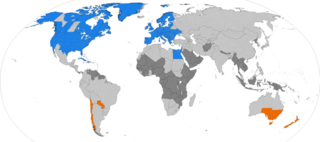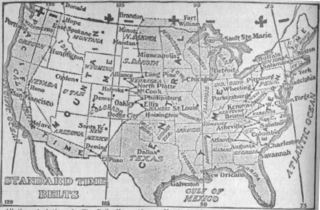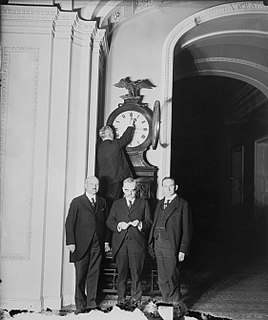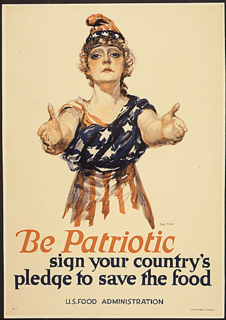Related Research Articles

Thomas Woodrow Wilson was an American politician and academic who served as the 28th president of the United States from 1913 to 1921. A member of the Democratic Party, Wilson served as the president of Princeton University and as the 34th governor of New Jersey before winning the 1912 presidential election. As president, he oversaw the passage of progressive legislative policies unparalleled until the New Deal in 1933. He also led the United States into World War I in 1917, establishing an activist foreign policy known as "Wilsonianism." He was the leading architect of the League of Nations.

Daylight saving time (DST), also daylight savings time or daylight time and summer time, is the practice of advancing clocks during warmer months so that darkness falls later each day according to the clock. The typical implementation of DST is to set clocks forward by one hour in the spring and set clocks back by one hour in autumn to return to standard time. In other words, there is one 23-hour day in late winter or early spring and one 25-hour day in the autumn.

The history of the United States from 1865 until 1918 covers the Reconstruction Era, the Gilded Age, and the Progressive Era, and includes the rise of industrialization and the resulting surge of immigration in the United States. This article focuses on political, economic, and diplomatic history.

The history of standard time in the United States began November 18, 1883, when United States and Canadian railroads instituted standard time in time zones. Before then, time of day was a local matter, and most cities and towns used some form of local solar time, maintained by some well-known clock. The new standard time system was not immediately embraced by all.

The New Freedom was Woodrow Wilson's campaign platform in the 1912 presidential election, and also refers to the progressive programs enacted by Wilson during his first term as president from 1913 to 1916 while the Democrats controlled Congress. First expressed in his campaign speeches and promises, Wilson later wrote a 1913 book of the same name. In terms of legislation, wartime policies are generally not considered part of the New Freedom. After the 1918 midterm elections, Republicans took control of Congress and were mostly hostile to the New Freedom. As president, Wilson focused on three types of reform:
- Tariff reform: This came through the passage of the Underwood Tariff Act of 1913, which lowered tariffs for the first time since 1857 and went against the protectionist lobby.
- Business reform: This was established through the passage of the Federal Trade Commission Act of 1914, which established the Federal Trade Commission to investigate and halt unfair and illegal business practices by issuing "cease and desist" orders, and the Clayton Antitrust Act.
- Banking reform: This came in 1913 through the creation of the Federal Reserve System and in 1916 through the passage of the Federal Farm Loan Act, which set up Farm Loan Banks to support farmers.

Australia uses three main time zones: Australian Western Standard Time, Australian Central Standard Time, and Australian Eastern Standard Time. Time is regulated by the individual state governments, some of which observe daylight saving time (DST). Australia's external territories observe different time zones.

Harry Augustus "Hal" Garfield was an American lawyer, academic and public official. He was president of Williams College and supervised the Federal Fuel Administration during World War I.

The U.S. state of Indiana is divided between Eastern and Central time zones. The official dividing line has generally moved progressively west from its original location on the Indiana–Ohio border, to a position dividing Indiana down the middle, and finally to its current location along much of the Indiana–Illinois border. In April 2006, several southwestern and northwestern counties reverted to Central time, although by late 2007 all but two had returned to Eastern time.
The Daylight Saving Act of 1917 was enacted by the Dominion of Newfoundland to adopt daylight saving time (DST), thus making it one of the first jurisdictions in North America to do so, only a year after the United Kingdom on May 21, 1916. DST was not instituted in the United States until March 31, 1918.

The presidency of Woodrow Wilson began on March 4, 1913 at noon when Woodrow Wilson was inaugurated as president of the United States, and ended on March 4, 1921. Wilson, a Democrat who previously served as the governor of New Jersey, took office as the 28th U.S. President after winning the 1912 presidential election, gaining a large majority in the Electoral College and a 42% plurality of the popular vote in a four–candidate field. Wilson was re-elected in 1916, defeating Republican Charles Evans Hughes by a fairly narrow margin. He was the first Southerner to be elected president since Zachary Taylor in 1848, and just the second Democrat to be elected president since 1860.

Mexico uses four main time zones since February 2015. Most of the country observes Daylight Saving Time.
- Zona Sureste covers the state of Quintana Roo is UTC-05:00 year round. It is the equivalent of U.S. Eastern Standard Time, and is the only Mexican state to use Eastern Time.
- Zona Centro covers the eastern three-fourths of Mexico, including Mexico City, Guadalajara and Monterrey. For most of the year, it is the equivalent of U.S. Central Time.
- Zona Pacífico covers the states of Baja California Sur, Chihuahua, Nayarit, Sinaloa, and Sonora. The state of Sonora, like the U.S. state of Arizona, does not observe daylight saving time. For most of the year, it is the equivalent of U.S. Mountain Time.
- Zona Noroeste covers the state of Baja California. It is identical to U.S. Pacific Time, including the daylight saving time schedule.

Daylight saving time in the United States is the practice of setting the clock forward by one hour during the warmer part of the year, so that evenings have more daylight and mornings have less. Most areas of the United States and Canada observe daylight saving time (DST), the exceptions being Arizona, Hawaii, and the overseas territories of American Samoa, Guam, the Northern Mariana Islands, Puerto Rico, and the United States Virgin Islands. The Uniform Time Act of 1966 established the system of uniform daylight saving time throughout the US.

Harry Cornwall Wheeler was an Arizona lawman who was the third captain of the Arizona Rangers, as well as the sheriff of Cochise County, serving from 1912 into 1918. He is known as the lead figure in the illegal mass kidnapping and deportation of some 1200 miners and family members, many of them immigrants, from Bisbee, Arizona to New Mexico in 1917. Beginning on July 12, 1917, he took total control of the town of Bisbee, controlling access and running kangaroo courts that deported numerous people.

The history of coal mining in the United States goes back to the 1300s, when the Hopi Indians used coal. The first commercial use came in 1701, within the Manakin-Sabot area of Richmond, Virginia. Coal was the dominant power source in the United States in the late 1800s and early 1900s, and although in rapid decline it remains a significant source of energy in 2019.

The Food and Fuel Control Act, Pub.L. 65–41, 40 Stat. 276, enacted August 10, 1917, also called the Lever Act or the Lever Food Act was a World War I era US law that among other things created the United States Food Administration and the Federal Fuel Administration.

The United States homefront during World War I saw a systematic mobilization of the country's entire population and economy to produce the soldiers, food supplies, ammunitions and money necessary to win the war. Although the United States entered the war in April 1917, there had been very little planning, or even recognition of the problems that Great Britain and the other Allies had to solve on their own home fronts. As a result, the level of confusion was high in the first 12 months.

The U. S. Food Administration was the agency responsible for the administration of the U.S. army overseas and allies' food reserves during the United States participation in World War I. One of its important tasks was the stabilization of the price of wheat on the U.S. market. It was established by Executive Order 2679-A of August 10, 1917, pursuant to the Food and Fuel Control Act, and was abolished by another executive order, Executive Order 3320, on August 21, 1920.
Brazil observed daylight saving time (DST) in the years of 1931–1933, 1949–1953, 1963–1968 and 1985–2019. Initially it applied to the whole country, but from 1988 it applied only to part of the country, usually the southern regions, where DST is more useful due to a larger seasonal variation in daylight duration.

As of 2017, daylight saving time is used in the following Asian countries:
Permanent standard time refers to the year-round observation of standard time. Likewise, permanent daylight saving time refers to the year-round observation of daylight saving time (DST). Both permanent standard time and permanent DST eliminate the practice of biannual clock changes, specifically the advancement of clocks by one hour from standard time to DST in spring and the retraction of clocks by one hour from DST to standard time in fall. In the United States, Arizona, Hawaii, and all territories observe permanent standard time. Observation of permanent DST is forbidden by the Uniform Time Act.
References
- ↑ GARFIELD ASKS AID OF COAL CONSUMERS; Wants Them to Co-operate in Enforcing Prices Fixed by Him. TO NAME STATE AGENTS Seeks Voluntary Arrangements with Operators for Adjustment of Contracts. The New York Times. September 8, 1917
- ↑ GARFIELD TO FIX RETAIL COAL PRICES; Administrator Likely to Make Announcement Before Oct. 1 The New York Times. September 11, 1917
- ↑ PRICE FIXED FOR LAKE COAL.; $6.20 to $7 for Run of Mine on Michigan and Superior October 29, 1917
- ↑ GOVERNOR ARRIVES TO PICK FUEL HEAD; L. T. Harkness Looked On as Most Likely to Be the Administrator The New York Times.on August 31, 1922 states: "... Mr. Outerbridge said the Federal Fuel Administration was 'dissolving and going home,' indicating that the failure of the Washington officials to continue to function withdrew needed support from the local fuel officials."